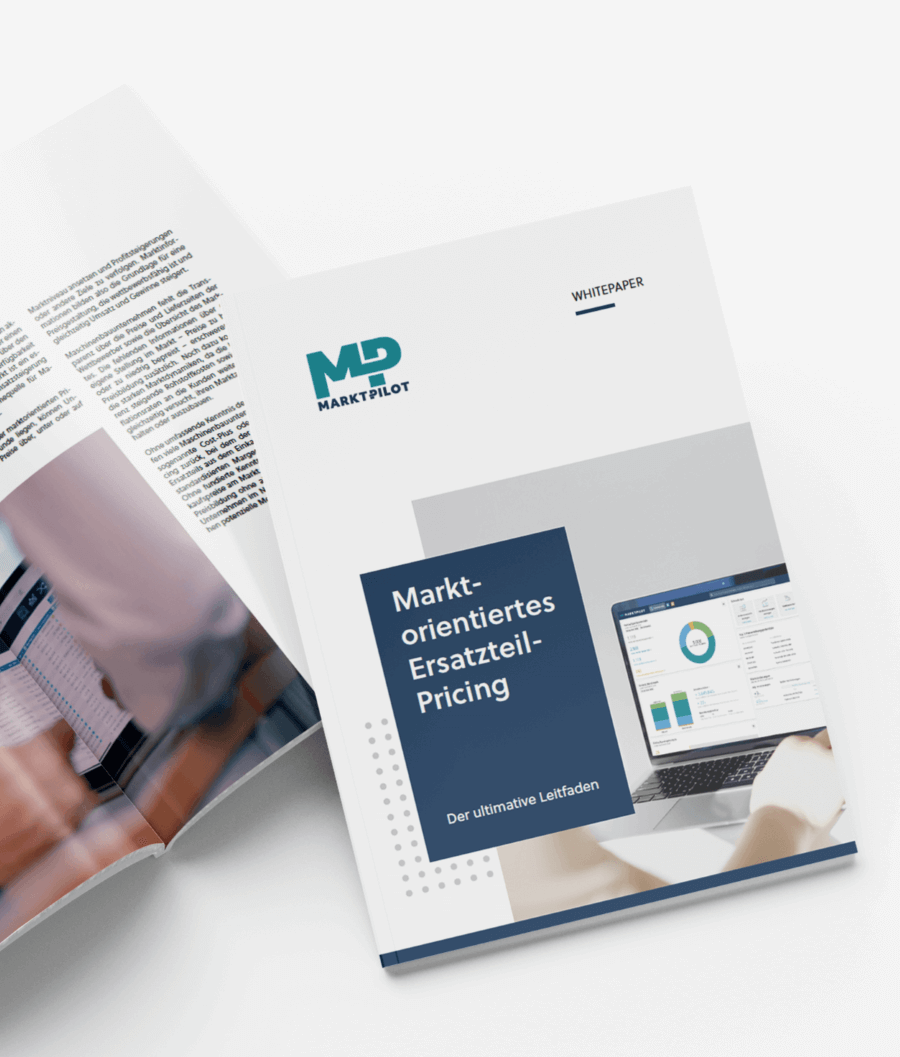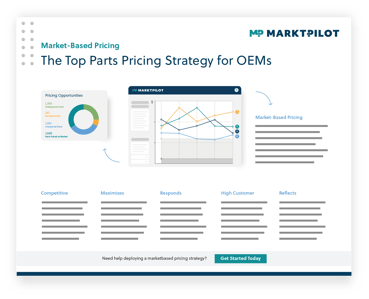Learn more about PRICERADAR today.
Utilize price intelligence, ai-powered real-time market insights to strengthen your spare parts business!
Boost your profitability and market position. Price intelligence empowers machine manufacturers with strategic insights to optimize spare parts pricing in a dynamic market. Our whitepaper provides the key knowledge and tools to enhance competitiveness and drive profitability.
Price intelligence is essential across industries, offering companies insights for strategic pricing. For machine manufacturers, it ensures competitiveness and maximizes pricing potential, particularly in managing spare parts pricing within a dynamic market.
Learn all about price intelligence and understand how it can benefit your business. Our whitepaper equips you with the necessary knowledge and tools to thrive in today's volatile and competitive market.

Price intelligence is essential across industries, offering companies insights for successful e-commerce and retail strategies.
It involves the systematic collection, analysis, and use of pricing pricing data to make informed business decisions. This price data insights enables companies to stay competitive in the market by understanding the pricing strategies of their competitors, identifying pricing trends and consumer behaviors, then interpreting this data to establish a pricing strategy that aligns with their business goals.
In the digital market, where consumers have numerous options and seamless access to information, pricing is a critical factor in purchasing decisions. Customers are becoming increasingly price-conscious and tend to compare prices across different platforms before making a purchase. Therefore, companies must monitor and comprehend the pricing dynamics within their industry. In other words: They need insight to the market.
This requires gathering data from various sources such as competitor websites, online marketplaces and historical pricing records. Advanced techniques like web scraping and data analytics tools are used to efficiently collect and process this data. Price intelligence tools, specifically designed for machine manufacturers and powered by artificial intelligence (AI), enable OEMs to quickly access precise and robust market data. The information gathered is then carefully analyzed to identify patterns, trends and valuable insights that can inform pricing strategies.
There are several types of price intelligence data tailored to different industry needs.
Market price tracking offers diverse applications across various industries. In machine manufacturing, price intelligence helps companies set competitive prices for parts and equipment based on market data and demand. Retailers use price intelligence to dynamically adjust prices across online and in-store channels to remain competitive. For agriculture, where costs and demand can shift seasonally, price intelligence enables data-driven pricing adjustments that reflect current market conditions.
Price intelligence enables OEMs to closely monitor and analyze their competitors' pricing strategies. By gathering data on competitor pricing across different channels and markets, OEMs can gain insights into market trends, identify pricing gaps, and adjust their own pricing accordingly. This allows them to stay competitive and make informed decisions to capture market share.
When introducing new products to the market, OEMs can leverage price intelligence to determine the optimal pricing for their offerings. By analyzing pricing data of similar products in the market, they can identify price points that maximize profitability while remaining attractive to customers. This helps OEMs position their products effectively and achieve a successful launch, ensuring they are priced competitively from the start.
OEMs often sell spare parts through various channels, including authorized dealers, service centers, and online platforms. Price intelligence helps OEMs maintain consistency in pricing across these channels. By monitoring and comparing prices, OEMs can identify any discrepancies or unauthorized price variations. This allows them to take corrective actions, such as adjusting pricing or addressing pricing deviations, to maintain a consistent pricing structure and protect their brand image.
By analyzing market data, OEMs can identify the demand for specific spare parts and determine the optimal pricing for aftermarket offerings. This allows them to capture additional revenue opportunities and build long-term customer loyalty by offering competitively priced and readily available spare parts.
Price intelligence enables OEMs to closely monitor and analyze their competitors' pricing strategies. By gathering data on competitor pricing across different channels and markets, OEMs can gain insights into market trends, identify pricing gaps, and adjust their own pricing accordingly. This allows them to stay competitive and make informed decisions to capture market share.
When introducing new products to the market, OEMs can leverage price intelligence to determine the optimal pricing for their offerings. By analyzing pricing data of similar products in the market, they can identify price points that maximize profitability while remaining attractive to customers. This helps OEMs position their products effectively and achieve a successful launch, ensuring they are priced competitively from the start.
OEMs often sell spare parts through various channels, including authorized dealers, service centers, and online platforms. Price intelligence helps OEMs maintain consistency in pricing across these channels. By monitoring and comparing prices, OEMs can identify any discrepancies or unauthorized price variations. This allows them to take corrective actions, such as adjusting pricing or addressing pricing deviations, to maintain a consistent pricing structure and protect their brand image.
By analyzing market data, OEMs can identify the demand for specific spare parts and determine the optimal pricing for aftermarket offerings. This allows them to capture additional revenue opportunities and build long-term customer loyalty by offering competitively priced and readily available spare parts.
To effectively price parts in the machine manufacturing industry, while implementing price intelligence data:

Combine real-time market intelligence with price intelligence data and take your parts business to the next level.

Implement a dynamic pricing strategy for parts using market intelligence. Consider factors such as demand, availability, and lead times to adjust prices in real time. By leveraging price intelligence and monitoring market trends and competitor pricing, you can optimize part pricing for maximum profitability and responsiveness to market dynamics.
Market-based parts pricing for OEMs refers to a pricing strategy where the cost of parts is determined by market forces such as supply and demand, competition, and other market factors. Instead of relying solely on internal cost calculations or fixed pricing models, OEMs set the prices of their parts based on the prevailing market conditions.
With market-based parts pricing, OEMs are able to monitor the prices of similar parts offered by other competitors in the market. They analyze factors such as the quality, availability, and demand for these parts to determine a fair and competitive price for their offerings. By considering market conditions, OEMs can adjust their pricing to reflect changes in costs, demand fluctuations, or the introduction of new technologies.
This strategy enables OEMs to optimize their profit margins while ensuring their prices remain attractive to customers, ultimately leading to increased sales and market share. Market-based parts pricing encourages OEMs to stay agile, responsive, and adaptive to the ever-changing dynamics of the market, fostering a competitive and sustainable business environment.

Track competitor prices, leverage market-data and make informed pricing decisions. Our Ultimate Guide to Market-Based Pricing dellivers actionable insights for success in the parts business. Read more now!
Track competitor prices, leverage market-data and make informed pricing decisions. Our Ultimate Guide to Market-Based Pricing dellivers actionable insights for success in the parts business. Read more now!

With market-based parts pricing, OEMs are able to monitor the prices of similar parts offered by other competitors in the market. They analyze factors such as the quality, availability, and demand for these parts to determine a fair and competitive price for their offerings. By considering market conditions, OEMs can adjust their pricing to reflect changes in costs, demand fluctuations, or the introduction of new technologies.
This strategy enables OEMs to optimize their profit margins while ensuring their prices remain attractive to customers, ultimately leading to increased sales and market share. Market-based parts pricing encourages OEMs to stay agile, responsive, and adaptive to the ever-changing dynamics of the market, fostering a competitive and sustainable business environment.
Next, we will go through the existing potentials together and do a plausibility test - validating the results once again by defining value drivers and then forming intersections from them.
Using market share potential as an example, we visualize the individual steps for realization and show you a few classic value drivers as examples.
Price intelligence software are now being leveraged to analyze the effects of inflation and tariffs on consumer behavior and adjust pricing accordingly. Businesses are using historical and real-time pricing data to identify optimal price points that balance profitability with customer demand and market offerings during periods of volatilty.
Nowadays, it has become common for buyers to come across different prices for identical parts across multiple online marketplaces. If a potential customer notices that your part is being advertised at a significantly higher price compared to your competitors in a particular marketplace, it's highly likely that they will choose not to purchase yours. It's quite possible that your part is available at half the price in another marketplace.
AI-powered price intelligence tools are invaluable assets, especially in today’s evolving digital world. They use sophisticated algorithms and machine learning and are starting to be used to collect and analyze pricing data from various sources, like competitor websites, marketplaces, and historical trends.
AI swiftly processes and interprets this data, providing actionable insights for real-time pricing decisions. It also identifies patterns and anomalies, helping companies optimize pricing strategies and respond to market fluctuations. Integrating AI in price intelligence will revolutionize how businesses navigate pricing in the years to come.

Learn about the other pricing strategies that incorporate price intelligence and market intelligence by checking out our article.
Investing in a price intelligence software like PRICERADAR offers OEMs punctual insights while streamlining the process of gathering data. Such software holds immense value in terms of accuracy and timeliness.
Realize untapped potential for price increases.
Gain market share through newfound market insight.
Heightened customer loyalty through fair prices.
Utilize price intelligence, ai-powered real-time market insights to strengthen your spare parts business!
Cross-selling and up-selling initiatives are among the most effective levers in the spare parts business. Find out why!
Explore the key manufacturing trends shaping 2026 and learn how to turn uncertainty into opportunity with actionable insights for machine...
Discover how Okuma boosted parts profitability with MARKT-PILOT’s data-driven pricing strategy.